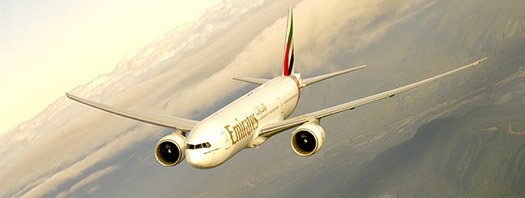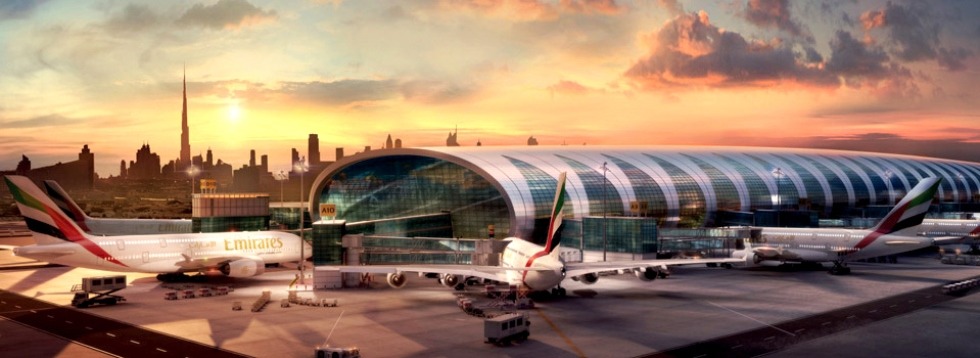Emirates: Flying at its premium best

A 30 year young carrier from the desert plains of UAE is taking over the international skies
Emirates airline is the world’s largest international airline. Its network comprises of over 140 destinations in 80 countries across 6 continents and the carrier transported over 49 million passengers in 2014-15. All its flights origin from Dubai International airport where the airline has an exclusive terminal dedicated to its fleet. In addition to its passenger business, Emirates also has a vast cargo business, which supports the core business.
Born in 1985 to compensate for Gulf Air’s reduced focus on the region, the airline has grown leaps and bounds in the past 30 years and is now a proud owner of 230, mostly wide-body aircraft. It aims to be the global carrier of choice and offers long haul flights that connect passengers traveling from Asia to Europe and North/South America and vice versa with only a single stop at Dubai. Multiple daily flights to and from all the major cities in the world ensure a quick layover in Dubai. The in-flight catering and entertainment services promise a pleasant flying experience and its exclusive priority lounges for business and first class passengers provide an additional layer of value.
To serve its ever-growing international passenger base, Emirates hires and trains an internationally diverse crew. This means that each emirates flight caters to multiple international languages, especially the language of the country of origin and destination. It has one of the largest terminals, Terminal 3 at Dubai airport, dedicated to its operations. It also has a brand new concourse to serve its ever-growing A380 fleet. It provides dual gated access to the two floors of the aircraft thus ensuring faster passenger turnaround. The fleet primarily consists two aircraft types – Boeing 777 and Airbus A380. Both are wide-body and can travel long distances to and from Dubai.
There is a strong alignment between Emirates’ business and operating models.
 1. A dedicated terminal has multiple advantages: Terminal 3 at Dubai is one of the largest buildings in the world (in terms of area covered). It is a state of the art airport with excellent facilities to feed, entertain and house Emirates’ transit passengers. The size allows the airline to expand its passenger base continuously and reduce cost per passenger. It is a critical enabler of carrier’s success because of no restrictions on night-time flying. This means that Emirates can schedule its flights in a way to arrive just in time for critical connections between major international cities. Arriving at your destination after a long flight and learning that your bag has been left behind is one of the biggest pain points of air travellers. A fully automated baggage handling system ensures that bags in transit are quickly and correctly transferred from one plane to another.
1. A dedicated terminal has multiple advantages: Terminal 3 at Dubai is one of the largest buildings in the world (in terms of area covered). It is a state of the art airport with excellent facilities to feed, entertain and house Emirates’ transit passengers. The size allows the airline to expand its passenger base continuously and reduce cost per passenger. It is a critical enabler of carrier’s success because of no restrictions on night-time flying. This means that Emirates can schedule its flights in a way to arrive just in time for critical connections between major international cities. Arriving at your destination after a long flight and learning that your bag has been left behind is one of the biggest pain points of air travellers. A fully automated baggage handling system ensures that bags in transit are quickly and correctly transferred from one plane to another.
 2. The fleet: Emirates maintains a very young fleet which allows it to provide and capture a lot of value. Firstly, maintenance and fuel costs are low because newer aircrafts are more efficient while passengers enjoy a modern and comfortable interior. Secondly, owning just two varieties of aircrafts reduces training and maintenance facilities costs. A modern fleet promotes perception of safety and quality, which are critical value propositions in the airline industry. The 777 is the backbone of Emirates’ fleet and is one of the safest aircrafts in operation today. The internal mood lighting and an on-demand entertainment system with touch screens (even in Economy class) ensure that passengers are engaged throughout the flight. The airline also consistently invests in new airplanes with more than 280 new orders in pipeline.
2. The fleet: Emirates maintains a very young fleet which allows it to provide and capture a lot of value. Firstly, maintenance and fuel costs are low because newer aircrafts are more efficient while passengers enjoy a modern and comfortable interior. Secondly, owning just two varieties of aircrafts reduces training and maintenance facilities costs. A modern fleet promotes perception of safety and quality, which are critical value propositions in the airline industry. The 777 is the backbone of Emirates’ fleet and is one of the safest aircrafts in operation today. The internal mood lighting and an on-demand entertainment system with touch screens (even in Economy class) ensure that passengers are engaged throughout the flight. The airline also consistently invests in new airplanes with more than 280 new orders in pipeline.
The aforementioned alignment between its business and operational model enables the company to offer a lot of value for its customers and resultantly capture value by achieving scale and reducing costs. As Dubai prepares to host Expo 2020, Emirates is positioning itself to handle a significant increase in its customer base leading up to that. Also, amid falling oil prices, it would be interesting to see how much of that value does the airline capture and how much it passes on to its customers.
Sources:
1. https://www.emirates.com
2. https://en.wikipedia.org/wiki/Emirates_fleet
3. http://www.emirates.com/english/about/the_emirates_story.aspx
4. http://www.wsj.com/articles/emirates-considers-new-boeing-777-order-1433864803



Having been a customer of Emirates on several flights, I completely agree that a dedicated terminal and a new set of fleets were extremely important parts of Emirates’ operating model that enhanced my experience as a customer. In addition, I was also very impressed by the high level of customer service that I received during my flights. From the ground staff to the air hostess, not only did they complete their required tasks efficiently, they also went beyond to ensure I had the best possible experience. I believe that it is this customer-focus service part of their operating model that distinguishes Emirates from other airlines and caters to fulfill a complete customer journey from start to finish (even in economy class!). Emirates’ operating model, for me, clearly supports its business model of providing a ‘premium best’ to the customers.
I find the age of the fleet a very interesting aspect of the Emirates operating model that you laid out above. It will be interesting to see if that changes over time. Per Bloomberg (http://www.bloomberg.com/visual-data/best-and-worst//oldest-fleets-airlines) many of the low cost airlines such as SouthWest tend to have older fleets, however Cathay Pacific, who also offers luxury service to Asia, has an average aircraft age of 13 years. If the age of the fleet is providing substantial enough fuel and maintenance benefits for Emirates then it seems reasonable that average aircraft age will remain similar over time despite pressure from falling oil prices, however this will be something to watch.
Thank you for such an interesting post!
I read a very interesting article on Emirates. You can find it at: https://www.scribd.com/fullscreen/12475327?access_key=key-2fu1hlah6tlra1sy48mu&allow_share=true&escape=false&view_mode=scroll
The article mentions that the location of the main hub of Emirates, Dubai, is also a very important factor for the success of the company. Almost 3.5 billion people live a 8-hour flight away from this city. And many of these people are in emerging markets! The opportunities for growth are huge.
Also, the Government of Dubai finances a significant part of the operations of the airport. Airlines fly there because they pay lower fees compared to those at other airports. Regional flights of Emirates, – and many other airlines – consistently feed the 777s and A380s of Emirates for long-haul flights, the ones that are really profitable.
I’ve been a loyal customer of Emirates for 3 years now (100+ flights), and I agree with the comments made above. Emirates is the opposite of a budget airline. Their selling point is their premium product, and their premium service. They win over their customers with their “wow” factor. That includes their new airplanes (flying business/first class on the A380 is an absolute treat—showers and heated bathroom floors in first class, open bar lounge with couches in the upper deck, etc.), Terminal 3 at DXB (with its first and business class lounges), and free limos picking up business and first class passengers to and from airports. They pay great attention to detail to the customer journey, especially with their highest paying customers.
Another product that has helped Emirates is their frequent flyer program (partnering with Qantas) which is aligned with their business model. Emirates’ program, Skywards, benefits from the vast network that Emirates covers globally, making it worthwhile for any customer to join. They have four tiers that they publicly advertise—blue, silver, gold, and platinum, and an invitation-only (IO) tier for most frequent flyers (it’s very hard to get there, we’re talking >500,000 miles/year). I’ve had the fortune of accompanying an IO member on a flight from Rome to Dubai once. We were driven in a Mercedes from the hotel to the airport. When we reached the airport, we were taken through a backdoor where someone checked our passports and gave us boarding passes, and within 5 minutes we were in the first class lounge. We were the first passengers to board the plane (just as flight attendants themselves were boarding), and were the first passengers to be let off the plane when landing, when a golf cart was waiting for us right outside the aircraft to take us to passport control. Emirates never fails to “wow” its customers, especially their best paying ones.
Just to add on to this — I’m very interested to see how Emirates will hold up as its two equally financially-capable competitors in the Middle East–Qatar Airways and Etihad (based on Doha and Abu Dhabi, respectively) ramp up their efforts to displace Emirates as the main carrier in the Middle East.